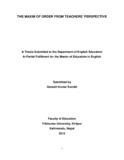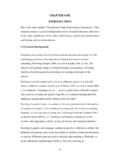Please use this identifier to cite or link to this item:
https://elibrary.tucl.edu.np/handle/123456789/281| Title: | The Maxim of Order from Teachers' Perspective |
| Authors: | Kandel, Ganesh Kumar |
| Keywords: | Ianguage;Classroom behavior |
| Issue Date: | 2012 |
| Publisher: | Central Departmental of Education English |
| Abstract: | The thesis entitled "The Maxim of Order from Teachers' Perspective" is an attempt tofind out the teachers' perception towards the maxim of order. Moreover, this study is anattempt to find out the teachers' classroom behavior or culture of teaching which is thereflection of their belief system and maxim. This study was mainly conductedconsidering the fact that it adds a brick in the field of teacher development and ELT andhelps English teachers to make their class lively. Similarly, this studywas conducted byconsidering the fact that why most of the Nepalese teachers prefer the maxim of order intheir classroom which is reflected in their culture of teaching. The study was carried outto find out the teachers' perception towards the maxim of order and to find out theirclassroom behavior/culture of teaching as well. To meet the objectives of this research,10 teachers who were teaching in different schools of Surkhet district were selected as theprimary sources of data. They were interviewed and 3 classes of each teacher wereobserved. This research concludes that most of the Nepalese teachers have got positiveattitude towards the maxim of order. They believe that it is easier to teach and learn thelanguage if there is calm and peaceful environment throughout the lesson. Similarly, mostof the Nepalese teachers want to maintain formal relationship with their student and wantto be respected from their students all the time.I have divided this thesis into four chapters: Introduction, Methodology, Analysis andInterpretation and Findings and Recommendations. The first chapter deals with thegeneral background, review of the related literature, objectives of the study and thesignificance of the study. The second chapter contains the methodologywhich is sub-chaptered as the sources of data, population of the study, sampling procedure, tools fordata collection, process of data collection and the limitations of the study. The thirdchapter includes the analysis and interpretation of the data obtained from the field. Thelast or fourth chapter reports the findings along with recommendations in which somepedagogical implications have been recommended on the basis of the findings of thestudy. |
| URI: | http://elibrary.tucl.edu.np:8080/jspui/handle/123456789/281 |
| Appears in Collections: | English Language Education |
Files in This Item:
| File | Description | Size | Format | |
|---|---|---|---|---|
| Cover.pdf | 37.22 kB | Adobe PDF |  View/Open | |
| Chapter.pdf | 154.3 kB | Adobe PDF |  View/Open |
Items in DSpace are protected by copyright, with all rights reserved, unless otherwise indicated.
